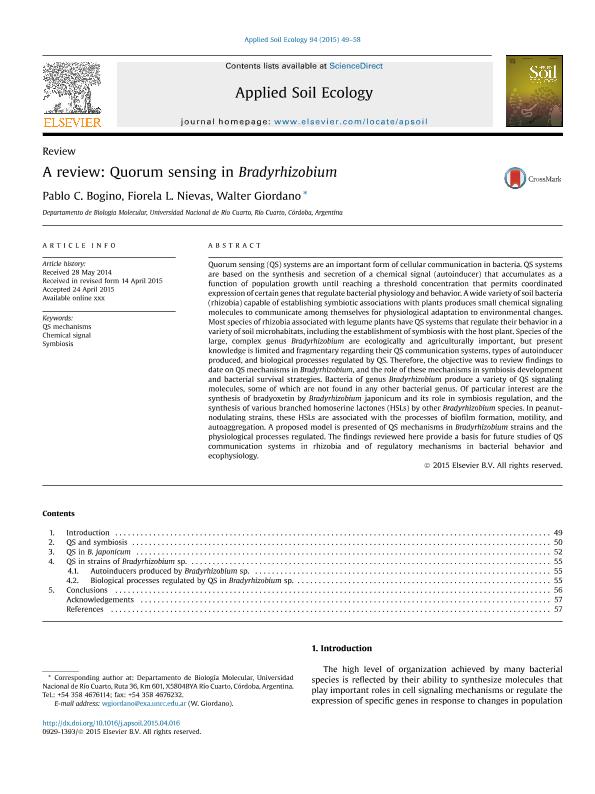Mostrar el registro sencillo del ítem
dc.contributor.author
Bogino, Pablo Cesar

dc.contributor.author
Nievas, Fiorela Lujan

dc.contributor.author
Giordano, Walter Fabian

dc.date.available
2018-10-03T18:45:12Z
dc.date.issued
2015-05
dc.identifier.citation
Bogino, Pablo Cesar; Nievas, Fiorela Lujan; Giordano, Walter Fabian; A review: Quorum sensing in Bradyrhizobium; Elsevier Science; Applied Soil Ecology; 94; 5-2015; 49-58
dc.identifier.issn
0929-1393
dc.identifier.uri
http://hdl.handle.net/11336/61563
dc.description.abstract
Quorum sensing (QS) systems are an important form of cellular communication in bacteria. QS systems are based on the synthesis and secretion of a chemical signal (autoinducer) that accumulates as a function of population growth until reaching a threshold concentration that permits coordinated expression of certain genes that regulate bacterial physiology and behavior. A wide variety of soil bacteria (rhizobia) capable of establishing symbiotic associations with plants produces small chemical signaling molecules to communicate among themselves for physiological adaptation to environmental changes. Most species of rhizobia associated with legume plants have QS systems that regulate their behavior in a variety of soil microhabitats, including the establishment of symbiosis with the host plant. Species of the large, complex genus Bradyrhizobium are ecologically and agriculturally important, but present knowledge is limited and fragmentary regarding their QS communication systems, types of autoinducer produced, and biological processes regulated by QS. Therefore, the objective was to review findings to date on QS mechanisms in Bradyrhizobium, and the role of these mechanisms in symbiosis development and bacterial survival strategies. Bacteria of genus Bradyrhizobium produce a variety of QS signaling molecules, some of which are not found in any other bacterial genus. Of particular interest are the synthesis of bradyoxetin by Bradyrhizobium japonicum and its role in symbiosis regulation, and the synthesis of various branched homoserine lactones (HSLs) by other Bradyrhizobium species. In peanut-nodulating strains, these HSLs are associated with the processes of biofilm formation, motility, and autoaggregation. A proposed model is presented of QS mechanisms in Bradyrhizobium strains and the physiological processes regulated. The findings reviewed here provide a basis for future studies of QS communication systems in rhizobia and of regulatory mechanisms in bacterial behavior and ecophysiology.
dc.format
application/pdf
dc.language.iso
eng
dc.publisher
Elsevier Science

dc.rights
info:eu-repo/semantics/openAccess
dc.rights.uri
https://creativecommons.org/licenses/by-nc-sa/2.5/ar/
dc.subject
Chemical Signal
dc.subject
Qs Mechanisms
dc.subject
Symbiosis
dc.subject.classification
Otras Ciencias Biológicas

dc.subject.classification
Ciencias Biológicas

dc.subject.classification
CIENCIAS NATURALES Y EXACTAS

dc.title
A review: Quorum sensing in Bradyrhizobium
dc.type
info:eu-repo/semantics/article
dc.type
info:ar-repo/semantics/artículo
dc.type
info:eu-repo/semantics/publishedVersion
dc.date.updated
2018-10-01T15:45:43Z
dc.journal.volume
94
dc.journal.pagination
49-58
dc.journal.pais
Países Bajos

dc.journal.ciudad
Amsterdam
dc.description.fil
Fil: Bogino, Pablo Cesar. Universidad Nacional de Río Cuarto. Facultad de Ciencias Exactas Fisicoquímicas y Naturales. Departamento de Biología Molecular; Argentina
dc.description.fil
Fil: Nievas, Fiorela Lujan. Universidad Nacional de Río Cuarto. Facultad de Ciencias Exactas Fisicoquímicas y Naturales. Departamento de Biología Molecular; Argentina
dc.description.fil
Fil: Giordano, Walter Fabian. Universidad Nacional de Río Cuarto. Facultad de Ciencias Exactas Fisicoquímicas y Naturales. Departamento de Biología Molecular; Argentina
dc.journal.title
Applied Soil Ecology

dc.relation.alternativeid
info:eu-repo/semantics/altIdentifier/url/https://www.sciencedirect.com/science/article/pii/S0929139315300019
dc.relation.alternativeid
info:eu-repo/semantics/altIdentifier/doi/http://dx.doi.org/10.1016/j.apsoil.2015.04.016
Archivos asociados
